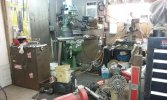- Joined
- Nov 27, 2013
- Messages
- 1,626
If it's a magnetic scale the first step will be to pull the sensor and reader and clean them thoroughly. Gunk on the scale or sensor will prevent them from reading, kind of like how an optical mouse doesn't want to track on certain surfaces. This does require some care.
Thanks for the response, I appreciate it. When you say “pull the sensor and reader,” do you mean the x axis cover on the front of the table? What should I clean it with? I was thinking about just cleaning the outside as well as possible prior to opening and then using air duster to blast the inside out, and then finally use an aerosol electric cleaner to clean it. The guy who I bought it from came by yesterday and that was when we ran into the problem. He recommended the “electronics cleaner” as he said it doesn’t leave a residue. Does anyone know what the name of this type of cleaner would be, or where it could be bought?
Thanks for your response guys. You all are lifesavers. I think, if I get this DRO thing figured out I should be good. I’m gonna go out there and try to mess with it here in a few. I’ll report back.

